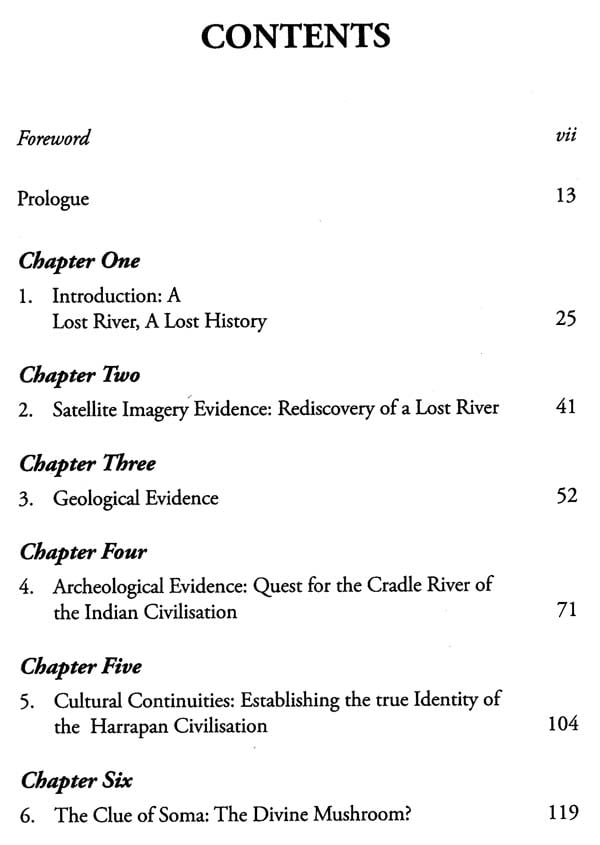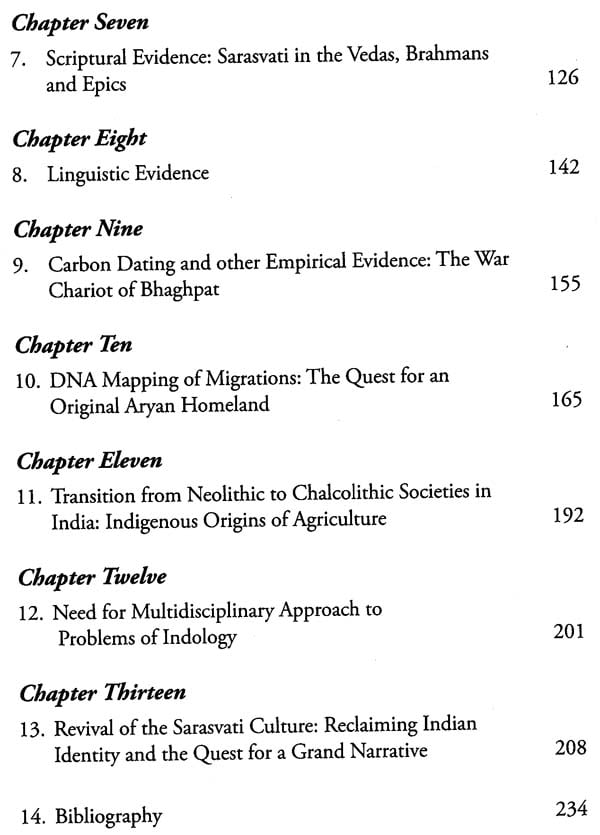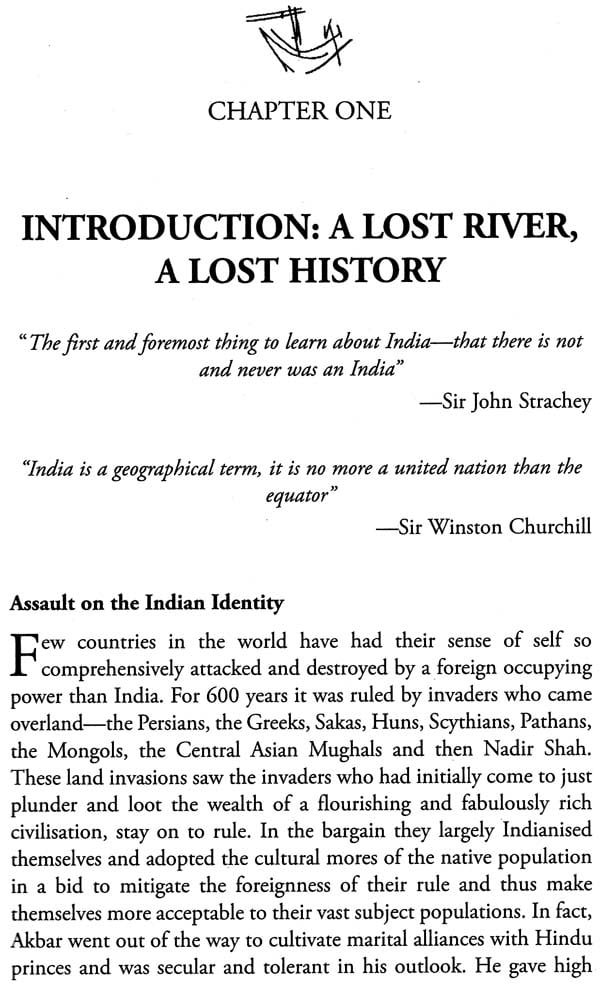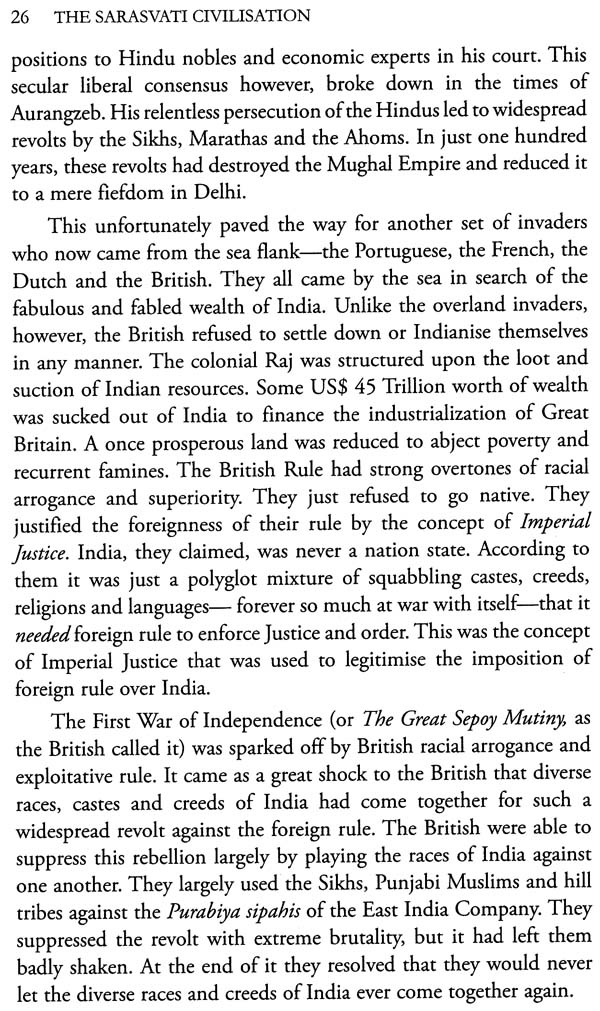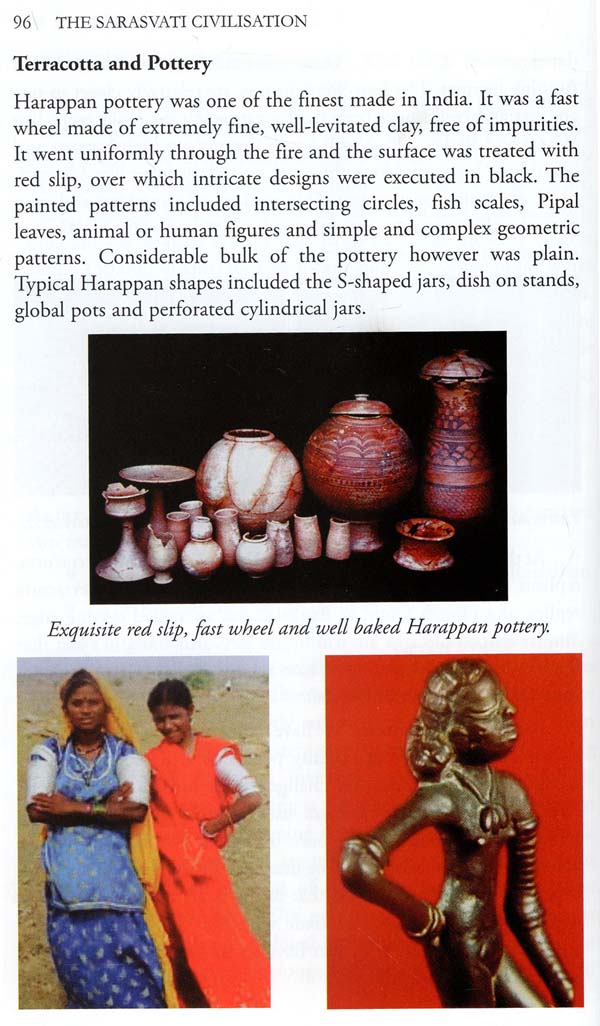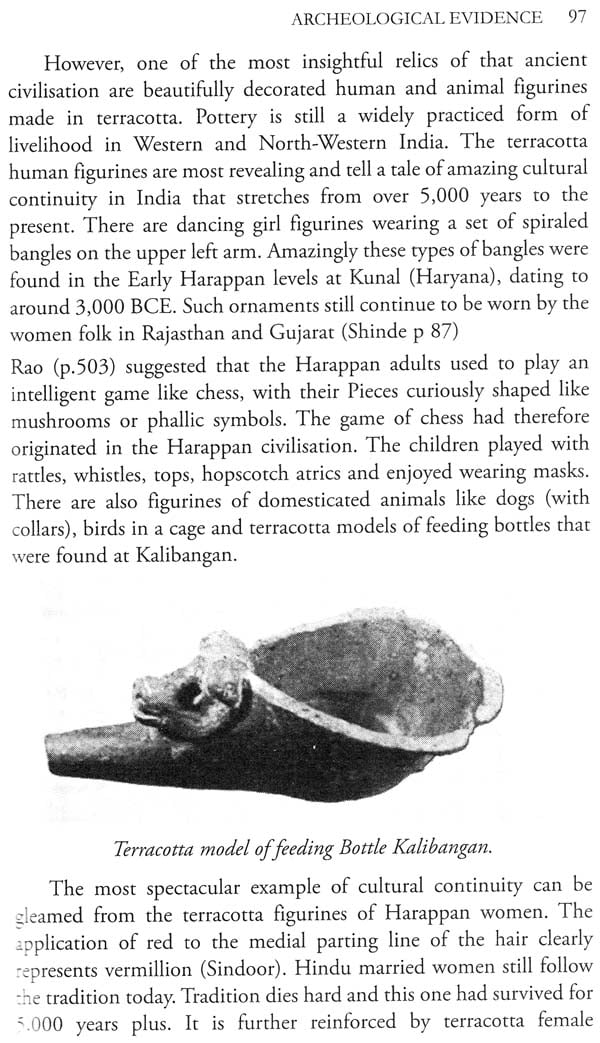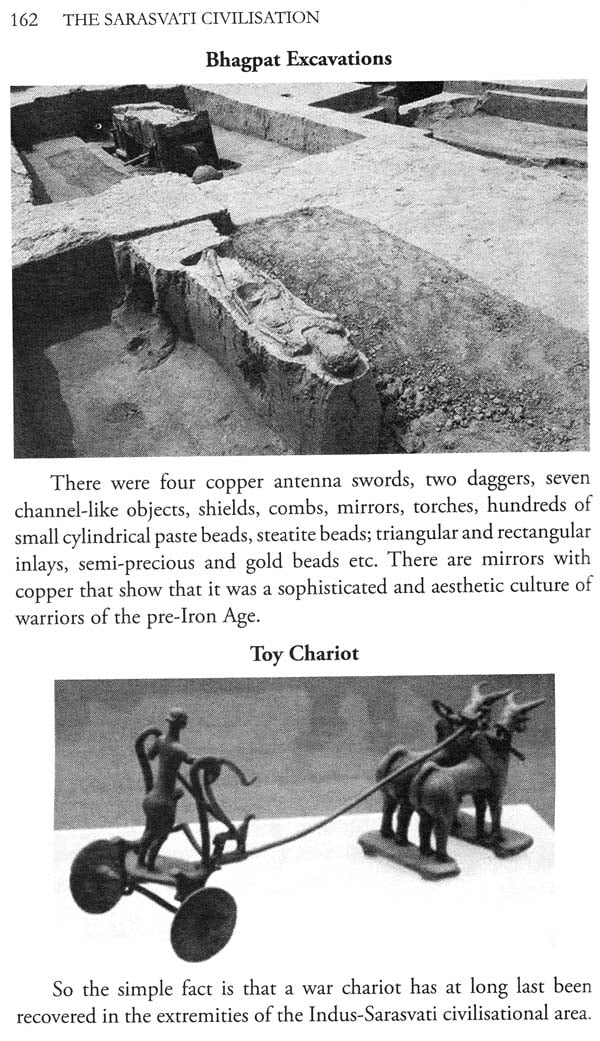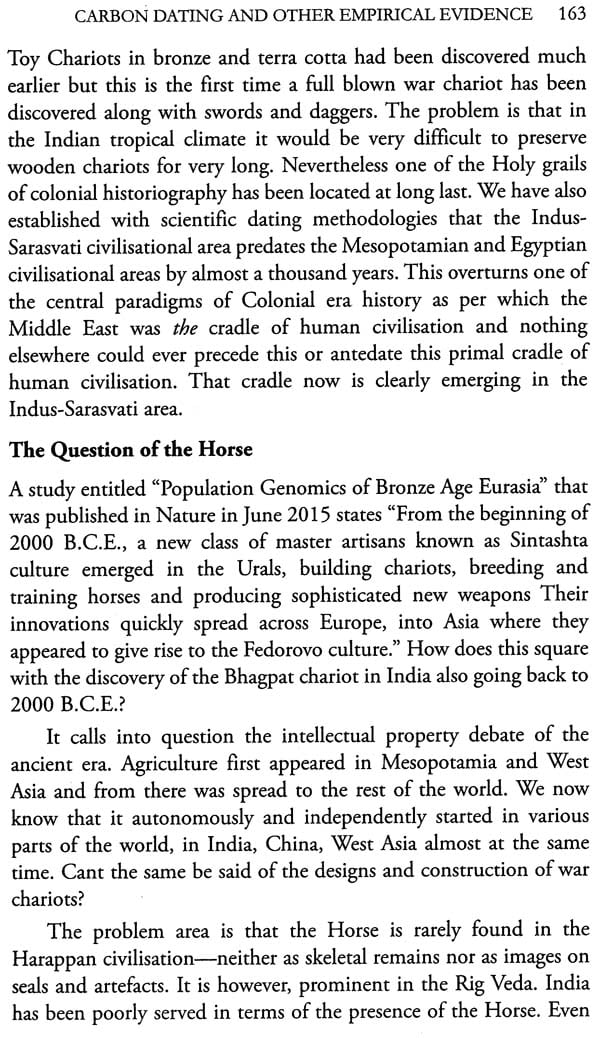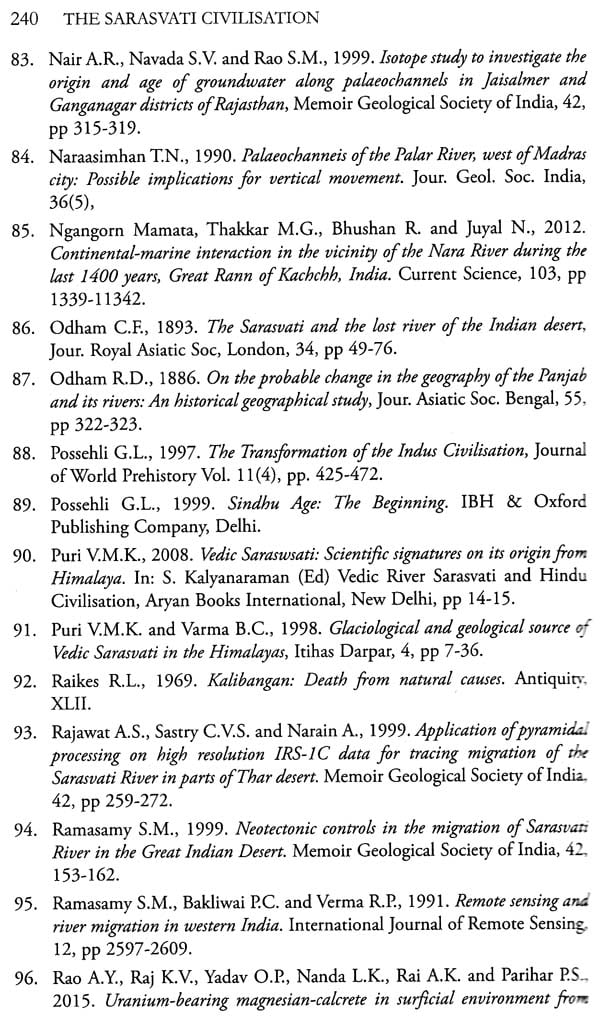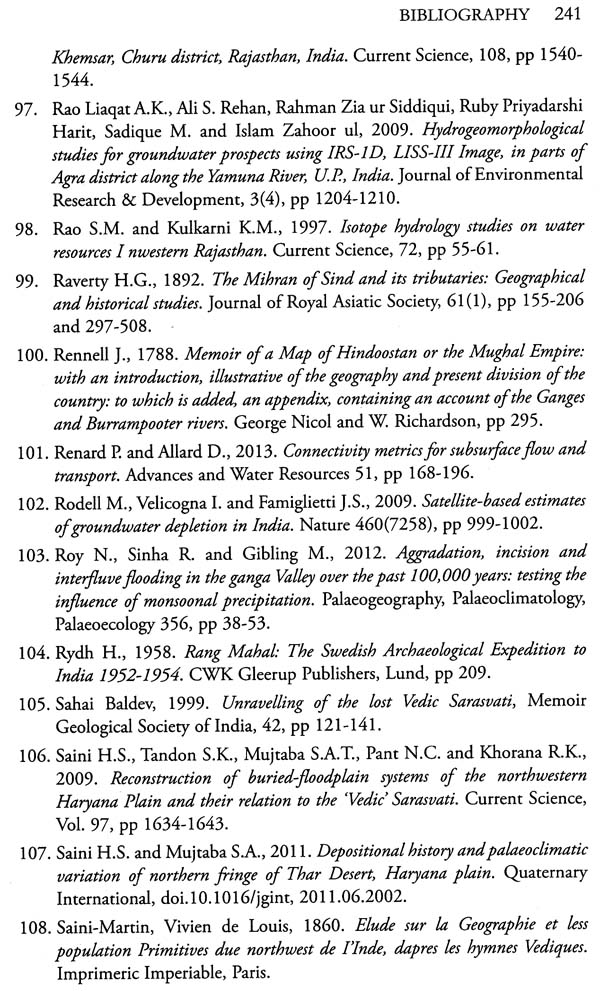
The Sarasvati Civilisation (A Paradigm Shift in Ancient History)
Book Specification
| Item Code: | NAV723 |
| Author: | G.D. Bakshi |
| Publisher: | Garuda Prakashan Pvt. Ltd. |
| Language: | English |
| Edition: | 2019 |
| ISBN: | 9781942426141 |
| Pages: | 274 (Throughout B/W and 4 Colored Illustrations) |
| Cover: | PAPERBACK |
| Other Details | 9.00 X 6.00 inch |
| Weight | 260 gm |
Book Description
Who were the Harappans? How are they related to present-day Indians? Was there ever an "Aryan Invasion"? The Sarasvati Civilization: A New Paradigm in Ancient Indian History brings together evidence from satellite imagery, geology, hydrodynamics, archaeology, epigraphy, textual hermeneutics and DNA research to place together ancient Indian history in the light of new discoveries and facts which were simply not available to colonial historians of the 19th century and have been overlooked thereafter. At the heart of the ancient Indian Civilization was the mighty Sarasvati river which was in full flow 5000-6000 years ago. 60-80 % of the so-called Indus Valley _ Civilisation sites which have been discovered are not on the banks of the Indus but on the course of the Sarasvati. The drying-out of the river is the most significant factor in the history and migrations of the ancient Indians. With new evidence, the time has come for a significant paradigm shift in Indology. This book breaks new ground to lay the foundation for an authentic Indian history.
Maj. Gen. G D Bakshi Military historian and decorated combat veteran Maj Gen (Dr ) G D Bakshi SM, VSM is an author of over thirty books and over three-hundred research papers in major journals. A graduate of the National Defence Academy, he has a PhD from the University of Madras. . He has written the official histories of the National Defence Academy and the National Defence College and his own J&K Rifles Regiment. He was honoured with the Chandra Shekhar Azad Rashtriya Samman Award for his contributions in the military, social and literary fields.
This is a book about a lost river that once sustained a civilisation spread over a vast area of some two million square kilometres. It was a mighty river, mightier perhaps than the Brahmaputra. It ran for 4,600 kms from the Himalayas to the Sea. It was in its prime some 5-6,000 years ago. Then around 1,900 B.C.E., it simply vanished due to a combination of tectonic plate shifts and a monotonic weakening of the monsoons.
What is amazing is the way the memory of this once mighty river was preserved for four thousand years in India’s oral traditions and in its scriptures. Most colonial historians deemed it a myth, but the memory of a sacred stream that had vanished was preserved in the racial memory of South Asia with a tenacity that was astonishing. In the middle ages Akbar’s cavalry used the dried-out bed of this tiver for rapid north south movements to Gujrat. Colonial era cartographers and geologists like CF Oldham speculated that the Ghaggar-Hakra paleochannels were the Vedic Sarasvati. However till date, most Colonial and leftist historians refuse to recognize the existence of a river called Sarasvati. In the 1970s however the US sent up its Landsat satellite that beamed back pictures of the dried- out course of a once mighty river in North Western India. The river was not a myth anymore. It was now an empirical fact.
Scores of satellites launched by ISRO have since confirmed the course of a once mighty river that dominated the civilisational jandscape in the Indian subcontinent. It was the cradle river of the Indian civilisation. More than 60% of the sites of the so-called Indus Valley civilisation were located along the dried-out course of the Sarasvati and not the Indus. It was an amazing civilisation spread over a vast landmass of some 2 million sq. kms. What has been remarkable is the degree of homogeneity of this vast civilisation.
Even more surprising is the astonishing degree of cultural continuity that it exhibits with the present-day Hindu civilisation in Northern and Western India.
Though the Indus Valley script has still not been deciphered, there were a whole host of terracotta figurines recovered from the Indus- Sarasvati valley sites, that depicted Yoga postures, meditating priests, a Proto Shiva Linga and yoni symbolisms; and the vermilion in the median parting of hair, bindis and bangles and other accoutrements worn by Hindu women even today. Since the Indus- Sarasvati valley civilisation occupied precisely the same geographical area described in the Rig Vedas and other Hindu scriptures, it was natural to ask whether the Harappan civilisation and the Rig Vedic Aryan civilisation were indeed one and the same. This narrative has been hotly contested.
For this, flew in the face of the trenchant narratives propagated by the colonial historians of British India. Max Mueller and Sir Mortimer Wheeler had decreed that the Indo-Aryans who composed the Rig Veda and laid the foundation of present-day Hindu religion, were foreigners. They had come from an Aryan homeland in the Steppes of Central Asia in the Bronze Age (around 1,500 B.C.) and destroyed the indigenous Indus valley civilisation with their war chariots and horsed cavalry, which gave them an overwhelming military advantage over the "dark skinned and snub nosed Dravidians" of the Indus Valley tradition. Indra, the Aryan war god, had destroyed a hundred fort cities and committed large scale genocide that drove the poor Dravidians South of the Vindhyas. The Aryans and Dravidians were viewed as racial categories by the colonial historians. This was the celebrated Aryan Invasion Theory (AIT).
The fact however is that not a shred of evidence was ever found to substantiate such a large-scale slaughter and genocide of the Indus Valley civilisation. Just 38 skeletons were found at one site and 11 at another. Even these did not bear any mark of swords and spear cuts. It was a genocide sans corpses. The AIT was therefore given a quiet burial and deftly replaced by the Indo-Aryan Migration Theory (IAMT). The Aryans had not actually invaded, it was now said. They had just streamed in wave after wave of migrations. A whole new set of evidence from multiple sources now clearly indicates that even this theory was untenable.
Let us examine some of the reasons:
The river Saraswati is a historical river of India mentioned frequently in the early Vedic text. The basin of river Saraswati, which gave India its true cultural identity, is considered to be cradle of civilization. Once a mighty river attracted the earliest Civilization of South Asia, the settlements of which are found densely scattered along its banks and the tributaries. The river disappeared suddenly around 2000 BCE and the earliest mighty Harappan Civilization of the country began to decline, which impacted the settlement pattern of the early cultures in the region. There is absolutely no clue for the disappearance event of the Saraswati river, but the analysis of the recent archaeological data is indicating that the river became insignificant around 2000 BCE. There are settlements of the Early Harappan (5500 BCE-2600 BCE) and the Mature Harappan (2600-2000 BCE) along the banks of the river, whereas the Late Harappan settlements (after 1900 BCE) have moved away from the main tiver course. This signifies that the river most probably disappeared around 2000 BCE and hence the Harappan people began to move away from its banks, into the tributary zone.
Right from the beginning of 18" century researchers are trying to verify the location of the Vedic Saraswati and understand causes and consequences of its disappearance. Multidisciplinary approaches adopted by scholars and involvement of agencies like over a period of last decade have resulted into confirmation of the location of the tiver, which is today named as Ghaggar-Hakra in the northwest India. It is now confirmed scientifically that the river originated in the lower Siwalik ranges, running through Punjab, Haryana, Western Rajasthan into the Bahawalpur district in Pakistan, which runs down straight into the Kuch part of Gujarat before meeting the sea. Considering the density of the Harappan sites in the basin, one can safely identify them as the Vedic people mentioned in the Vedic text. It is therefore suggested a strong bond between the river Saraswati and the Rg Vedic people.
Though this is the most important river system in the country and large a number of Harappan sites have been discovered and excavated in the basin, there is still lack of systematic and scientific multi-disciplinary approach to the basic issues. Scholars have published in bits and plieces on the ancient river system and the archaeological data retrieved from this region in a scattered way. The present book by Maj. Gen. Bakshi therefore assumes greater significance as it has not only collated data at one place but also incorporates most recent discoveries and scientific data available till date. Through this book G.D. Bakshi it trying to resolve some of the vexing issues related to the ancient river Saraswati system. I would like to highlight the following issues and resolutions aptly raised by the author and add my comments.
"The quest for an ancient river that was irrevocably lost some 3,900 years ago, is quintessentially a quest for a lost sense of self in the Indian civilization. It is in essence, a quest for unravelling its true identity. It is about — Who are we as Indians? Who were the Indo- Aryans who have laid the foundation for our present day Hindu culture in India? Were they aliens or were they indigenous? If they were aliens, where did they come from? Where is the mythical Aryan homeland? Is it in Turkey- Anatolia? Or is it in the Steppes of Central Asia? Where do Indians have to go in quest for their roots? Which is the proto Indo-European language that diffused all over Europe and Asia from this mythical Aryan homeland? Did the Aryans invade India in the Bronze Age? Was the Aryan war god Indra guilty of horrific genocide? Did he and his cohorts destroy a 100 fort cities of the so called Indus valley civilization? Where then is the evidence of that large scale slaughter and destruction? The Indus valley civilization did not have a hundred fort cities. An accurate count shows only 10 Cities (a city would have a land area of a 100 hectares or more-on that yardstick even some of these 10 cities would qualify as just towns). The AIT suffers from a host of infirmities and it is about time that we questioned the received wisdom of the colonial era’.
The genetic as well as archaeological data available so far needs to be properly synthesized for holistic understanding of the issues raised so far. The migrations theory without strong evidence propounded by some scholars is a deliberate attempt to mislead the people. The archaeological as well as genetic data available so far needs careful assessment. It is now becoming increasing clear that is no mass migration of the people into the Indian subcontinent for last 10000 years. The evidence from Mehrgarh in Pakistan and Bhirrana and Girawad sites in the Saraswati basin in India clearly demonstrates indigenous development. There is an evidence of the origins of the local cultural traditions around 7000 BCE, which gradually matured and evolved into a full-fledged indigenous urban society in the middle of the third millennium BCE. This early culture formed the foundation of the Indian culture and tradition. Of course there is admixture of the population from different regions because of the trade links. This is reflected in both the cultural as well genetic data. The research has clearly demonstrated that the so called Aryan Invasion Theory is a hoax and has no substance. In last 10,000 years there is no mass migration into the South Asia.
The new information generated through scientific research on Rg Vedic Saraswati and Aryan issues need to find a place into text books so that the people are aware about the true history of the country. I must congratulate Maj. Gen. Bakshi for taking initiative and writing this important comprehensive books highlighting important issues related to the history and culture of the Saraswati basin. This book will be immensely useful to scholars as well as layman also.
